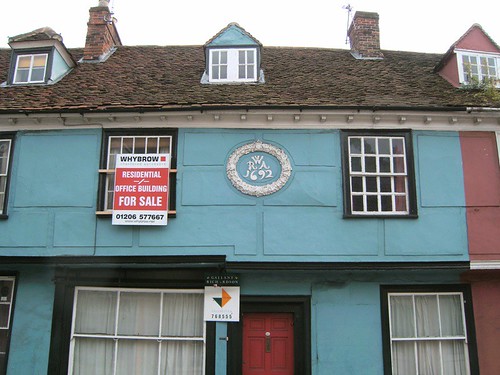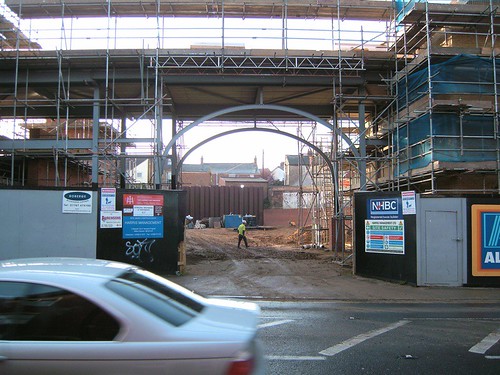26 January, 2007
Results of a US survey just published in the Lancet suggest that living too near a busy road can stunt a child's lung development. Read more at the BBC News website. As Town Hall continues to approve countless additional developments, merrily ignoring Colchester's already choked streets, perhaps somebody should warn new residents that their children may not have much puff in later life.
25 January, 2007
Allowing a name to keep its meaning

Apparently, some of the last remaining buildings at the Hythe are to be demolished. They are not architecturally special, neither are they very old. However, they are the last of the working buildings, right on the riverside, from the Hythe's heyday and, as such they have enormous significance. They also constitute an important (and completing) component of the lower part of Hythe Hill. They carry the last visual clues that give people access to an important period of Colchester's history, and are inestimably more meaningful than archive photgraphs, important as they may be. Allowing them to remain adds another dimension to the experience of visiting, living or working in the neighbourhood. Knocking them down and then renaming the replacement "Old Wharf Heights" or similar will add insult to injury. There's plenty of good new building design further down river (I shan't comment now on the sad 'wharfism' in between), so let's see what good can be done here. See more pictures of the old Hythe area. For location, see map, waypoint 8.
Community Stadium builders appointed
Colchester Borough Council reports that it has appointed Barr Ltd to build the new multi-million pound Community Stadium, and selected Drivers Jonas as project managers for the construction stage. However, a number of further preliminaries still need to be settled before the building contract can be signed and building work started. Read more on the council's news release page.
19 January, 2007
The problem with buses

It's received wisdom that public transport causes less pollution than the use of private cars. To the pedestrian, child in a buggy or cyclist however, the opposite feels true. The bus roars past (bus drivers are always accelerating, braking or swerving to maximize the jerky effect) and we all know what to expect: a swirling fog of warm, particulate-laden, diesel exhaust through which we must hold our breath until we are clear. Bus exhaust outlets seem designed to do this deliberately, pointing down towards the road surface to ensure an even distribution of toxic gases at the breathing level. This is not how it has to be. Many continental cities have buses whose exhausts vent vertically. Granted the gases have to go somewhere and upper-storey windows over the street may have to stay closed during busy times. But the city of Florence solves this by using smaller, electric buses for the clogged inner city routes. Most big trucks have vertical exhausts. Why not buses, which spend so much of their journeys belching their way past pedestrians in narrow streets?
05 January, 2007
East Hill and East Street

East Hill and East Street together must have as many old timber buildings as the Dutch quarter. Alright, I haven't actually counted, but take a walk along this ancient (often traffic-choked) highway and be impressed. Some have been restored and are maintained magnificently (for example, Charlie Brown's), others look tired, while not a few appear almost terminal. Star attractions in East Street include The Siege House and the Rose and Crown. The brick buildings are to be noted, too (there are some grand ones on East Hill). The former East Mill is an imposing pile, and there are some interesting finds in East Bay, opposite. It's an attractive spot at the river, marred a bit by the sorry state of East Bridge itself – whatever happened to to its missing lamp posts? See also post on East Bridge below. See more pictures of East Street, and of East Hill. For location, see map, waypoint 6.
04 January, 2007
Magdalen Street, New Town

Colchester's old "commercial road" is Magdalen Street: the connecting thorougfare to the town's port. The port has gone, but the street still reflects some of its original character, both in the remaining architecture, and in its busyness. The new Aldi's (see picture above) should help keep things busy, at least. There are some very old buildings behind the plastic fascias and affordable double-glazing. To the north, by contrast, on land previously occupied by railway sidings, there's a new neighbourhood - all white and pretending to be classical - with amazing views over Colchester's secret inner green valley. Magdalen Street's reaching a tipping point: if any more of the old buildings go and are replaced with meaningless cod-Tudor/Georgian/Victorian styles, we'll be saying good-bye to another fascinating part of Colchester. For location of Magdalen Street area, see map, waymark 5. See more pictures in and around Magdalen Street.















